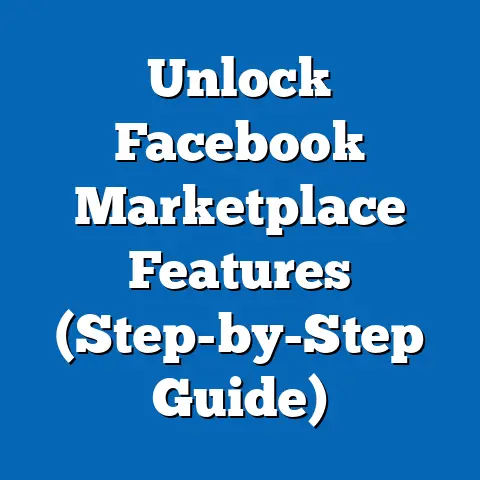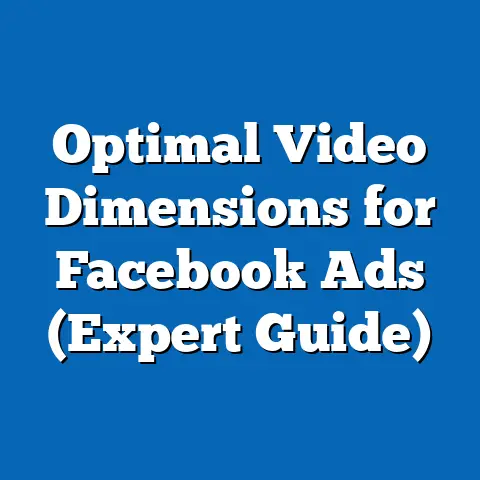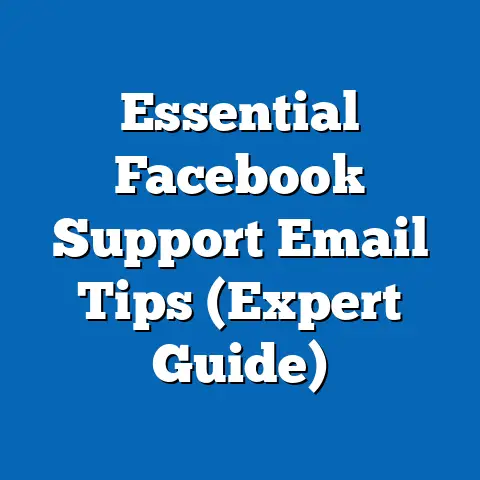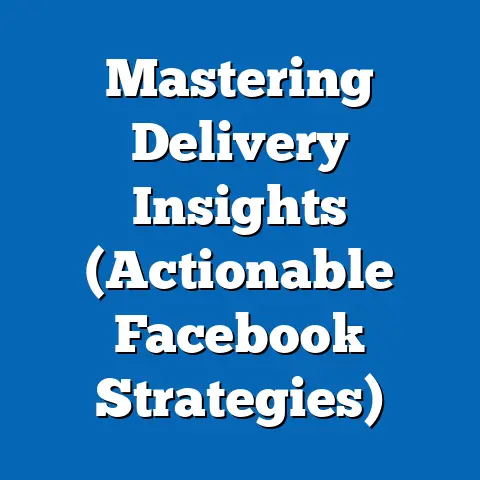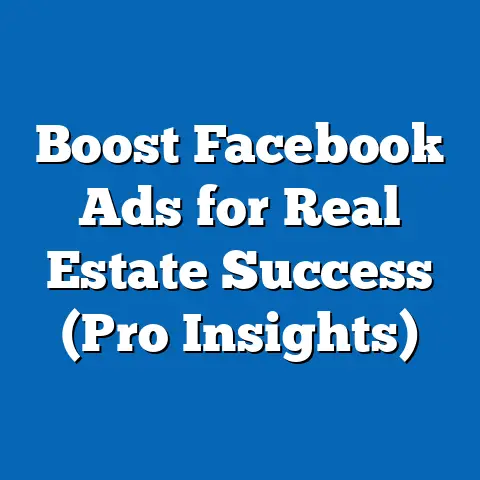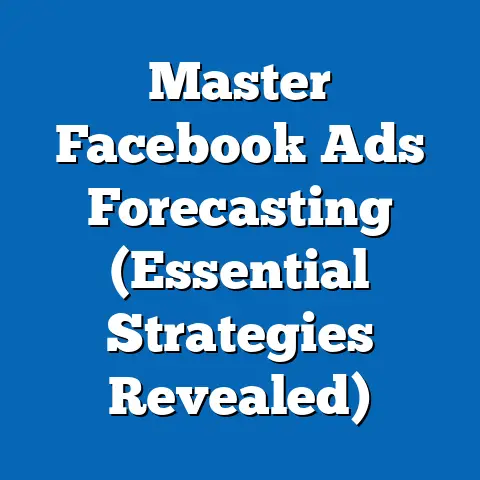Discover Sponsored Ads on Facebook (Expert Guide)
I’ve seen firsthand how a little warmth can transform a cold ad into a connection. In today’s digital landscape, where consumers are bombarded with countless advertisements daily, it’s not enough to simply present a product or service. You need to forge a genuine connection, evoke emotions, and build trust. This is where the concept of “warmth” in advertising comes into play, and Facebook sponsored ads can be a surprisingly effective tool for achieving it.
Warmth, in this context, refers to the emotional resonance your advertising creates with your audience. It’s about making them feel understood, valued, and connected to your brand on a human level. Think of those ads that make you smile, that tell a story that resonates with your own experiences, or that simply make you feel good about the brand. That’s warmth in action.
I’ve personally witnessed how a simple, heartfelt video ad about a local bakery’s community involvement outperformed a highly polished, product-focused ad by a significant margin. The bakery’s ad wasn’t about selling more pastries; it was about showcasing their values and their connection to the neighborhood. It was warm, authentic, and memorable.
Sponsored ads on Facebook offer a unique opportunity to create this warmth and build lasting relationships with potential customers. By strategically leveraging Facebook’s powerful targeting capabilities and creative ad formats, businesses can craft compelling campaigns that resonate with their audience on a deeper level.
Section 1: Understanding Sponsored Ads on Facebook
So, what exactly are sponsored ads on Facebook? Simply put, they are advertisements that businesses pay to display to a targeted audience on the Facebook platform. Unlike organic posts, which are only seen by your existing followers and their friends, sponsored ads have the potential to reach a much wider audience based on specific demographics, interests, and behaviors.
Think of it this way: you’ve built a fantastic brick-and-mortar store, but only people walking by will ever see it. Organic posts are like putting up a sign in your window – helpful, but limited. Sponsored ads are like taking out a billboard on a busy highway, ensuring that your message reaches a much larger and more relevant audience.
Facebook offers a variety of sponsored ad formats to suit different marketing goals and creative preferences. Here’s a quick rundown of some of the most popular options:
- Photo Ads: These are simple yet effective ads featuring a single image or graphic. They’re great for showcasing products, announcing promotions, or driving traffic to your website.
- Video Ads: Video ads are incredibly engaging and allow you to tell a more compelling story. They’re perfect for demonstrating product features, sharing customer testimonials, or creating brand awareness.
- Carousel Ads: Carousel ads allow you to display multiple images or videos in a single ad unit, each with its own headline, description, and link. This format is ideal for showcasing a range of products, highlighting different features of a single product, or telling a sequential story.
- Slideshow Ads: Slideshow ads are similar to video ads but use a series of still images to create a visually appealing experience. They’re a cost-effective alternative to video ads and can be just as effective in capturing attention.
The key difference between organic posts and sponsored content lies in their reach and targeting. Organic posts are primarily seen by your existing followers and their friends, while sponsored ads can be targeted to a specific audience based on a wide range of criteria. This allows you to reach potential customers who are most likely to be interested in your products or services, regardless of whether they already follow your page.
Furthermore, Facebook’s ad auction process plays a crucial role in determining which ads are displayed to which users. When you create a sponsored ad, you’re essentially entering a bidding war with other advertisers who are targeting the same audience. Facebook’s algorithm takes into account various factors, such as your bid amount, ad quality, and estimated action rates, to determine which ads are most likely to be successful and deliver the best results for both advertisers and users.
Key Takeaway: Sponsored ads are a powerful tool for expanding your reach, targeting specific audiences, and achieving your marketing goals on Facebook. Understanding the different ad formats and the ad auction process is essential for creating successful campaigns.
Section 2: Setting Up Your Sponsored Ads
Now that you have a basic understanding of sponsored ads, let’s dive into the process of setting up your first campaign. Don’t worry, it’s not as daunting as it might seem. I’ll break it down into clear, actionable steps:
-
Creating a Facebook Business Account:
Before you can start running ads, you’ll need a Facebook Business Account. This is separate from your personal Facebook profile and allows you to manage your business pages, ad accounts, and other business-related assets in one central location.
Think of it as the control panel for your entire Facebook marketing operation. It’s essential for running ads because it provides access to advanced features and analytics that are not available through a personal profile.
To create a Business Account, simply go to business.facebook.com and follow the instructions. You’ll need to provide some basic information about your business, such as its name, address, and website. 2. Navigating Ads Manager:
Ads Manager is the central hub for creating, managing, and analyzing your Facebook ad campaigns. It’s where you’ll define your target audience, choose your ad objectives, set your budget, design your ads, and track your results.
The Ads Manager interface can be a bit overwhelming at first, but once you get familiar with the different sections and functionalities, it becomes much easier to navigate.
Here’s a brief overview of the key areas:
- Campaigns: This is where you’ll create and manage your overall ad campaigns, which are essentially containers for your ad sets and ads.
- Ad Sets: Ad sets define your target audience, budget, and schedule for your ads.
- Ads: This is where you’ll design your individual ads, including the copy, visuals, and call-to-action.
- Reporting: This section provides detailed analytics on your ad performance, allowing you to track your results and make data-driven decisions.
- Defining Your Target Audience:
One of the most powerful features of Facebook advertising is its ability to target specific audiences based on a wide range of criteria. This allows you to reach potential customers who are most likely to be interested in your products or services, regardless of whether they already follow your page.
Facebook offers a variety of targeting options, including:
- Demographics: You can target users based on their age, gender, location, education, relationship status, and other demographic factors.
- Interests: You can target users based on their interests, hobbies, and the pages they like on Facebook.
- Behaviors: You can target users based on their online behavior, such as their purchase history, travel habits, and device usage.
For example, if you’re selling organic dog food, you might target users who are interested in dogs, organic food, and animal welfare. You could also target users who have recently purchased pet supplies online or who have visited websites related to dog care.
I once ran a campaign for a local bookstore that targeted users who were interested in specific authors and genres. The results were phenomenal, with a click-through rate that was significantly higher than the average. The key was to really understand the interests and preferences of the target audience and tailor the ads accordingly. 4. Choosing Ad Objectives:
Before you create your first ad, you’ll need to choose an advertising objective. This is the goal you want to achieve with your campaign, such as increasing brand awareness, generating leads, or driving conversions.
Facebook offers a variety of advertising objectives, each designed to optimize for a specific outcome. Here are some of the most common options:
- Brand Awareness: This objective is designed to increase the visibility of your brand and reach a wider audience.
- Reach: This objective is similar to brand awareness but focuses on maximizing the number of people who see your ad.
- Traffic: This objective is designed to drive traffic to your website or landing page.
- Engagement: This objective is designed to increase engagement with your ads, such as likes, comments, and shares.
- Lead Generation: This objective is designed to collect leads from potential customers through a lead form or other means.
- Conversions: This objective is designed to drive conversions on your website or app, such as purchases, sign-ups, or downloads.
Choosing the right advertising objective is crucial for the success of your campaign. If you’re trying to increase brand awareness, you’ll want to choose the brand awareness or reach objective. If you’re trying to drive sales, you’ll want to choose the conversions objective. 5. Budgeting and Bidding:
Finally, you’ll need to set your budget and choose a bidding strategy for your ads. Your budget is the amount of money you’re willing to spend on your campaign, and your bidding strategy determines how much you’re willing to pay for each click or impression.
Facebook offers two main budgeting options:
- Daily Budget: This is the average amount you’re willing to spend each day on your campaign.
- Lifetime Budget: This is the total amount you’re willing to spend on your campaign over its entire duration.
When it comes to bidding, Facebook offers two main strategies:
- Automatic Bidding: This allows Facebook to automatically set your bids based on your budget and advertising objective.
- Manual Bidding: This allows you to manually set your bids for each click or impression.
Automatic bidding is generally recommended for beginners, as it simplifies the process and allows Facebook to optimize your bids for the best results. However, if you have more experience with Facebook advertising, you may want to experiment with manual bidding to gain more control over your costs.
Creating a Facebook Business Account:
Before you can start running ads, you’ll need a Facebook Business Account. This is separate from your personal Facebook profile and allows you to manage your business pages, ad accounts, and other business-related assets in one central location.
Think of it as the control panel for your entire Facebook marketing operation. It’s essential for running ads because it provides access to advanced features and analytics that are not available through a personal profile.
To create a Business Account, simply go to business.facebook.com and follow the instructions. You’ll need to provide some basic information about your business, such as its name, address, and website. 2. Navigating Ads Manager:
Ads Manager is the central hub for creating, managing, and analyzing your Facebook ad campaigns. It’s where you’ll define your target audience, choose your ad objectives, set your budget, design your ads, and track your results.
The Ads Manager interface can be a bit overwhelming at first, but once you get familiar with the different sections and functionalities, it becomes much easier to navigate.
Here’s a brief overview of the key areas:
- Campaigns: This is where you’ll create and manage your overall ad campaigns, which are essentially containers for your ad sets and ads.
- Ad Sets: Ad sets define your target audience, budget, and schedule for your ads.
- Ads: This is where you’ll design your individual ads, including the copy, visuals, and call-to-action.
- Reporting: This section provides detailed analytics on your ad performance, allowing you to track your results and make data-driven decisions.
- Defining Your Target Audience:
One of the most powerful features of Facebook advertising is its ability to target specific audiences based on a wide range of criteria. This allows you to reach potential customers who are most likely to be interested in your products or services, regardless of whether they already follow your page.
Facebook offers a variety of targeting options, including:
- Demographics: You can target users based on their age, gender, location, education, relationship status, and other demographic factors.
- Interests: You can target users based on their interests, hobbies, and the pages they like on Facebook.
- Behaviors: You can target users based on their online behavior, such as their purchase history, travel habits, and device usage.
For example, if you’re selling organic dog food, you might target users who are interested in dogs, organic food, and animal welfare. You could also target users who have recently purchased pet supplies online or who have visited websites related to dog care.
I once ran a campaign for a local bookstore that targeted users who were interested in specific authors and genres. The results were phenomenal, with a click-through rate that was significantly higher than the average. The key was to really understand the interests and preferences of the target audience and tailor the ads accordingly. 4. Choosing Ad Objectives:
Before you create your first ad, you’ll need to choose an advertising objective. This is the goal you want to achieve with your campaign, such as increasing brand awareness, generating leads, or driving conversions.
Facebook offers a variety of advertising objectives, each designed to optimize for a specific outcome. Here are some of the most common options:
- Brand Awareness: This objective is designed to increase the visibility of your brand and reach a wider audience.
- Reach: This objective is similar to brand awareness but focuses on maximizing the number of people who see your ad.
- Traffic: This objective is designed to drive traffic to your website or landing page.
- Engagement: This objective is designed to increase engagement with your ads, such as likes, comments, and shares.
- Lead Generation: This objective is designed to collect leads from potential customers through a lead form or other means.
- Conversions: This objective is designed to drive conversions on your website or app, such as purchases, sign-ups, or downloads.
Choosing the right advertising objective is crucial for the success of your campaign. If you’re trying to increase brand awareness, you’ll want to choose the brand awareness or reach objective. If you’re trying to drive sales, you’ll want to choose the conversions objective. 5. Budgeting and Bidding:
Finally, you’ll need to set your budget and choose a bidding strategy for your ads. Your budget is the amount of money you’re willing to spend on your campaign, and your bidding strategy determines how much you’re willing to pay for each click or impression.
Facebook offers two main budgeting options:
- Daily Budget: This is the average amount you’re willing to spend each day on your campaign.
- Lifetime Budget: This is the total amount you’re willing to spend on your campaign over its entire duration.
When it comes to bidding, Facebook offers two main strategies:
- Automatic Bidding: This allows Facebook to automatically set your bids based on your budget and advertising objective.
- Manual Bidding: This allows you to manually set your bids for each click or impression.
Automatic bidding is generally recommended for beginners, as it simplifies the process and allows Facebook to optimize your bids for the best results. However, if you have more experience with Facebook advertising, you may want to experiment with manual bidding to gain more control over your costs.
Key Takeaway: Setting up your Facebook sponsored ads involves creating a Business Account, navigating Ads Manager, defining your target audience, choosing your ad objectives, and setting your budget and bidding strategy. Each step is crucial for creating a successful campaign that reaches the right audience and achieves your desired results.
Section 3: Designing Effective Sponsored Ads
Once you’ve set up the technical aspects of your campaign, it’s time to focus on the creative side. Designing effective sponsored ads is all about attracting attention, conveying your message clearly, and driving engagement.
-
Crafting Compelling Copy:
Your ad copy is your opportunity to connect with your target audience on a personal level and convince them to take action. It should be clear, concise, and compelling, highlighting the benefits of your product or service and addressing their pain points.
Here are some tips for writing engaging headlines and ad copy:
- Know Your Audience: Understand their needs, desires, and pain points. Tailor your message to resonate with their specific interests and concerns.
- Highlight the Benefits: Focus on the value you provide, not just the features of your product or service. Explain how you can solve their problems or improve their lives.
- Use Strong Verbs: Use action words that create a sense of urgency and encourage users to click.
- Keep it Concise: Get straight to the point and avoid unnecessary jargon or fluff.
- Ask Questions: Engage your audience by asking questions that pique their curiosity and encourage them to learn more.
- Evoke Emotion: Tap into their emotions by telling a story, sharing a testimonial, or using humor.
I once worked with a local coffee shop that was struggling to attract new customers. Their initial ad copy was bland and generic, simply stating “Best Coffee in Town.” We revamped their copy to focus on the experience of visiting their shop, highlighting the cozy atmosphere, friendly baristas, and delicious pastries. The new copy evoked a sense of warmth and community, and the ad performance improved dramatically. 2. Visual Elements:
Visuals are crucial for attracting attention and conveying your message quickly and effectively. High-quality images and videos can capture the eye, evoke emotions, and create a lasting impression.
Here are some tips for choosing visuals that align with your brand identity and resonate with your target audience:
- Use High-Quality Images: Avoid blurry or pixelated images. Use professional-quality photos that are well-lit and visually appealing.
- Choose Relevant Images: Select images that are relevant to your product or service and that resonate with your target audience.
- Use Videos: Video ads are incredibly engaging and allow you to tell a more compelling story.
- Maintain Brand Consistency: Use visuals that are consistent with your brand identity, including your logo, colors, and fonts.
- Test Different Visuals: Experiment with different images and videos to see what resonates best with your audience.
I’ve found that user-generated content (UGC), such as customer photos and videos, can be incredibly effective in building trust and credibility. When potential customers see real people using and enjoying your products, they’re more likely to be convinced to make a purchase. 3. Call-to-Action (CTA):
Your call-to-action (CTA) is the final nudge that encourages users to take the desired action, such as visiting your website, signing up for your newsletter, or making a purchase. It should be clear, concise, and compelling, telling users exactly what you want them to do and why they should do it.
Here are some examples of effective CTAs:
- Shop Now: This CTA is ideal for driving sales on your website.
- Learn More: This CTA is ideal for providing more information about your product or service.
- Sign Up: This CTA is ideal for collecting leads and building your email list.
- Download Now: This CTA is ideal for offering a free resource, such as an ebook or whitepaper.
- Contact Us: This CTA is ideal for encouraging users to reach out to you with questions or inquiries.
The key is to choose a CTA that aligns with your advertising objective and that is relevant to the content of your ad. For example, if you’re running a lead generation campaign, you’ll want to use a CTA that encourages users to sign up for your newsletter or request a free consultation.
Crafting Compelling Copy:
Your ad copy is your opportunity to connect with your target audience on a personal level and convince them to take action. It should be clear, concise, and compelling, highlighting the benefits of your product or service and addressing their pain points.
Here are some tips for writing engaging headlines and ad copy:
- Know Your Audience: Understand their needs, desires, and pain points. Tailor your message to resonate with their specific interests and concerns.
- Highlight the Benefits: Focus on the value you provide, not just the features of your product or service. Explain how you can solve their problems or improve their lives.
- Use Strong Verbs: Use action words that create a sense of urgency and encourage users to click.
- Keep it Concise: Get straight to the point and avoid unnecessary jargon or fluff.
- Ask Questions: Engage your audience by asking questions that pique their curiosity and encourage them to learn more.
- Evoke Emotion: Tap into their emotions by telling a story, sharing a testimonial, or using humor.
I once worked with a local coffee shop that was struggling to attract new customers. Their initial ad copy was bland and generic, simply stating “Best Coffee in Town.” We revamped their copy to focus on the experience of visiting their shop, highlighting the cozy atmosphere, friendly baristas, and delicious pastries. The new copy evoked a sense of warmth and community, and the ad performance improved dramatically. 2. Visual Elements:
Visuals are crucial for attracting attention and conveying your message quickly and effectively. High-quality images and videos can capture the eye, evoke emotions, and create a lasting impression.
Here are some tips for choosing visuals that align with your brand identity and resonate with your target audience:
- Use High-Quality Images: Avoid blurry or pixelated images. Use professional-quality photos that are well-lit and visually appealing.
- Choose Relevant Images: Select images that are relevant to your product or service and that resonate with your target audience.
- Use Videos: Video ads are incredibly engaging and allow you to tell a more compelling story.
- Maintain Brand Consistency: Use visuals that are consistent with your brand identity, including your logo, colors, and fonts.
- Test Different Visuals: Experiment with different images and videos to see what resonates best with your audience.
I’ve found that user-generated content (UGC), such as customer photos and videos, can be incredibly effective in building trust and credibility. When potential customers see real people using and enjoying your products, they’re more likely to be convinced to make a purchase. 3. Call-to-Action (CTA):
Your call-to-action (CTA) is the final nudge that encourages users to take the desired action, such as visiting your website, signing up for your newsletter, or making a purchase. It should be clear, concise, and compelling, telling users exactly what you want them to do and why they should do it.
Here are some examples of effective CTAs:
- Shop Now: This CTA is ideal for driving sales on your website.
- Learn More: This CTA is ideal for providing more information about your product or service.
- Sign Up: This CTA is ideal for collecting leads and building your email list.
- Download Now: This CTA is ideal for offering a free resource, such as an ebook or whitepaper.
- Contact Us: This CTA is ideal for encouraging users to reach out to you with questions or inquiries.
The key is to choose a CTA that aligns with your advertising objective and that is relevant to the content of your ad. For example, if you’re running a lead generation campaign, you’ll want to use a CTA that encourages users to sign up for your newsletter or request a free consultation.
Key Takeaway: Designing effective sponsored ads involves crafting compelling copy, choosing high-quality visuals, and using a strong call-to-action. By paying attention to these creative elements, you can create ads that attract attention, engage your audience, and drive results.
Section 4: Analyzing Performance and Optimizing Your Ads
Creating a great ad is only half the battle. The other half is tracking your performance, analyzing your results, and optimizing your campaigns for maximum impact.
Facebook provides a wealth of data and analytics that can help you understand how your ads are performing and identify areas for improvement. It’s crucial to regularly monitor your key performance indicators (KPIs) and make data-driven decisions to optimize your campaigns.
Here are some of the most important KPIs to consider:
- Click-Through Rate (CTR): This is the percentage of people who saw your ad and clicked on it. A high CTR indicates that your ad is relevant and engaging to your target audience.
- Conversion Rate: This is the percentage of people who clicked on your ad and completed the desired action, such as making a purchase or signing up for your newsletter. A high conversion rate indicates that your landing page is effective and that your offer is compelling.
- Cost Per Click (CPC): This is the average amount you’re paying for each click on your ad. A low CPC indicates that you’re targeting the right audience and that your ad is performing well.
- Cost Per Conversion (CPC): This is the average amount you’re paying for each conversion. A low CPA indicates that your campaign is efficient and that you’re getting a good return on your investment.
- Return on Ad Spend (ROAS): This is the amount of revenue you’re generating for every dollar you spend on advertising. A high ROAS indicates that your campaign is profitable and that you’re getting a strong return on your investment.
Facebook Analytics and Ads Manager reports provide detailed insights into your ad performance, allowing you to track these KPIs and identify trends over time. You can use this data to assess the effectiveness of your ads, identify areas for improvement, and make data-driven decisions about your campaigns.
One of the most effective ways to optimize your ads is through A/B testing. This involves creating multiple versions of your ad with different elements, such as the headline, copy, visuals, or CTA, and then testing them against each other to see which one performs best.
For example, you could create two versions of your ad with different headlines and then run them simultaneously to see which headline generates the highest CTR. Once you’ve identified the winning headline, you can then test other elements, such as the copy or visuals, to further optimize your ad.
I’ve consistently seen significant improvements in ad performance through A/B testing. It’s a simple yet powerful way to identify what resonates best with your audience and to continuously improve your campaigns.
Key Takeaway: Analyzing your ad performance and optimizing your campaigns is crucial for maximizing your ROI. By tracking your KPIs, using Facebook Analytics and Ads Manager reports, and conducting A/B tests, you can identify areas for improvement and make data-driven decisions to optimize your ads for the best results.
Section 5: Best Practices for Sponsored Ads
To wrap things up, let’s summarize some essential best practices for creating successful sponsored ads on Facebook. These are the tried-and-true strategies that I’ve found to be most effective over the years:
- Consistency in Branding: Maintain a consistent brand identity across all of your ads, including your logo, colors, fonts, and messaging. This will help to build brand recognition and create a cohesive brand experience for your audience.
- Understanding Platform Trends: Stay up-to-date with the latest trends and best practices on Facebook. The platform is constantly evolving, so it’s important to adapt your strategies accordingly.
- Staying Updated with Facebook’s Advertising Policies: Familiarize yourself with Facebook’s advertising policies and ensure that your ads comply with these guidelines. Violating Facebook’s policies can result in your ads being disapproved or your account being suspended.
- Scheduling Ads: Experiment with different ad schedules to see what works best for your target audience. Consider running ads during peak hours when your audience is most active on Facebook.
- Utilizing Retargeting Strategies: Retargeting allows you to show ads to people who have previously interacted with your website or Facebook page. This is a highly effective way to re-engage potential customers and drive conversions.
- Engaging with the Audience Through Comments and Messages: Monitor the comments and messages on your ads and respond promptly to any questions or concerns. This will help to build trust and create a positive brand experience for your audience.
Key Takeaway: By following these best practices, you can create sponsored ads that are not only effective but also ethical and sustainable. Remember that successful advertising is not just about selling products; it’s about building relationships and fostering warmth in brand interactions.
Conclusion
Facebook sponsored ads have the power to transform the way businesses connect with their audience. It’s not just about selling products or services; it’s about building relationships, fostering warmth, and creating a lasting impression.
I’ve seen countless businesses, big and small, achieve remarkable results through strategic Facebook advertising. From local coffee shops to national e-commerce brands, the potential is there for anyone willing to invest the time and effort to understand the platform and craft compelling campaigns.
Remember, the key to success is to focus on creating value for your audience, understanding their needs and desires, and building genuine connections. By implementing the strategies discussed in this guide, you can unlock the vast opportunities that Facebook advertising offers and take your business to the next level.
So, go ahead, experiment, learn, and adapt. The world of Facebook advertising is constantly evolving, but the principles of warmth, connection, and authenticity will always remain relevant. Embrace these principles, and you’ll be well on your way to creating sponsored ads that not only drive results but also build lasting relationships with your audience.

